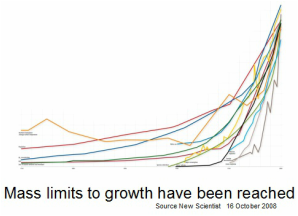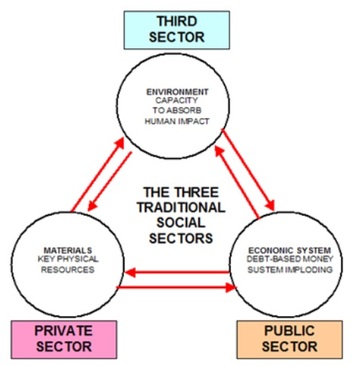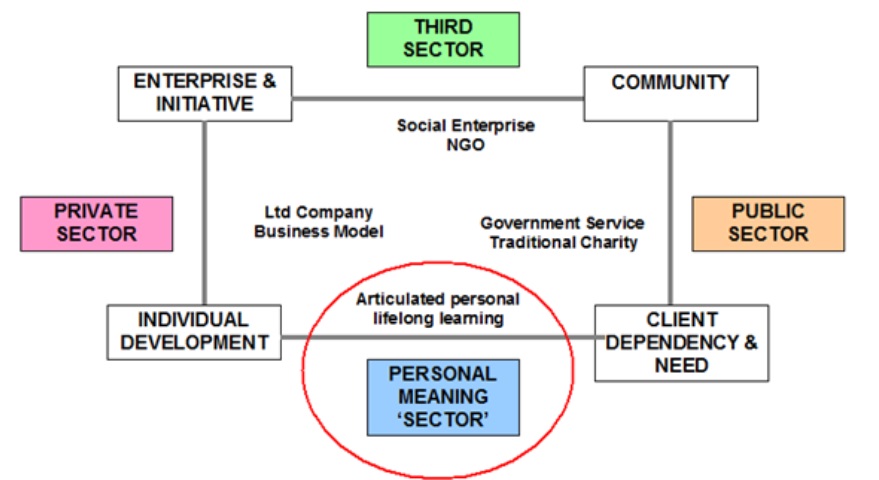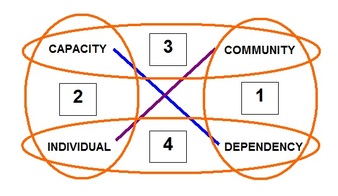From Three Sectors to Four:
Breaking the Social Log-jam
Breaking the Social Log-jam
Introduction
We live in a world that is increasingly and manifestly shown to be round, circular and finite. We face an ever increasing and desperate need to reform our social institutions and infrastructures to effectively respond to this evident and emerging reality and yet we are, for the most part, still saddled with an institutional framework that continues to feed and encourage notions of conflict and conquest that are themselves predicated on the notion that there is an infinite area of physical territories and resources beyond the organisational borders. One that can be plundered and appropriated indefinitely in order to feed the organised centre.
This implicit substrata of outmoded perception and conception continues to hamper genuine social and economic evolution even amongst those groups. initiatives and organisations that seek to reform it and bring about a more sustainable social infrastructure.
This implicit substrata of outmoded perception and conception continues to hamper genuine social and economic evolution even amongst those groups. initiatives and organisations that seek to reform it and bring about a more sustainable social infrastructure.
Limits to Physical Growth
|
Crumpled Earth
|
Furthermore, I suggest that the nature and accelerating effects of this feedback is driven by increases in the capacity for consciousness, that are themselves the result of shorter time-lapses between action and effect, or action and consequence. This shortening is the inevitable result of increasing amounts of human activity within a finite and limited physical spherical space. In other words, we live on a round spherical planet but we collectively act as if we live on an infinite and expanding plane, or flat earth.
|
I propose that the interactions that stimulate this enhanced consciousness development are becoming increasingly self-perpetuating. This is in spite of the natural tendency of our old centralised infrastructure model to attempt to limit and control the nature and content of interaction and the information that flows between people and organisations.

The increasing incapacity to re-exert centralised control is due to the natural 'echoing' feedback's of signals broadcast into a spherical and finite landscape, which echo back upon themselves in a way that if far more interactive than when similar signals are broadcast out across an apparently infinite plane. It follows that all attempts by the old system to preserve its nature will only serve to add more information into an environment that progressively undermines the institutional functionality of that system.
The Current Three-fold Nature of Social Organisations
|
Our current social organisations and institutions have arisen during the last 500 years during a phase that Professor Stuart Walker refers to as "modernity" In the social transformation from the late middle ages to the modern era the institutions of state have gradually shifted their relationship with non-state organisations away from those representing belief and the means to achieve personal salvation and towards the newly emerging organisational structures focused around enterprise and the provision of physical comfort and the relief of physical hardship.
|
Radical Design for Sustainability:
Professor Stuart Walker at TEDxBrum |
Underscoring both the organisations of state and enterprise has been a third movement representing personal liberation at a social and, more recently, an environmental level. This third set of organisations are usually referred to , appropriately enough, as organizations and movements belonging to the "Third Sector".
In spite of our shift from Medievalism to modernity, from a faith and progressively superstitious world view to one based on reason and direct conscious exploration we seem incapable of addressing and overcoming the fundamental limits to physical growth outlined above.
In spite of our shift from Medievalism to modernity, from a faith and progressively superstitious world view to one based on reason and direct conscious exploration we seem incapable of addressing and overcoming the fundamental limits to physical growth outlined above.
The Rise of the Third Sector
|
I would like to characterise this sector as one which broadly works for the liberty and free expression of the ordinary citizen and which champions the rights of 'ordinary' people' to co-exist within a socially equitable social framework and in a viable natural environment. Whilst it may be impossible to pinpoint the exact moment when what we now loosely refer to as the third sector first arose it is safe to say that it had its major organisational roots in the 19th century when the early 'grandfather' social and environmental movement was born.
|
Thus we arrive at our current social order with its three-way operating tension between the public and private sectors and the rapidly expanding third sector.
In spite of the development and rapid growth of third sector-community based initiatives it would appear that there is a collective failure to address the fundamental physical limits to growth and to adapt our organisational infrastructure and systems to cope with and overcome the multiple challenges and positive feedback's that are daily besetting the stability of society.
Introducing Personal Meaning into the Social Equation
Recent institutional attempts to introduce an indicator for measuring subjective value and personal meaning are at an early stage. Such indices as the World Happiness Report are designed to provide a counter-weight to such simplistic measures of personal and social well-being encapsulated in growth based economic indicators such as GDP. But there is, as yet, no convincing reconciliation of numerical measure and 'subjective' quality measures.
Taking my lead from the Person Centered Therapy Movement I suggest that there is no need to be able to directly convert subjective impressions and assessments of what constitutes a good life into an 'objective' number system. Instead I propose that self-assessments of what constitutes a rewarding and fulfilling life should be taken at face value and the evaluation of whether one is fulfilled by the direction ones life is taking should be left entirely to the individual concerned.
In order to provide a more comprehensive and constructive social architecture I propose that we move beyond the current ‘three pronged’ model of public, private and civil and add a fourth emerging social agent namely that of the Personal Meaning Sector.
The Personal Meaning Sector deliberately and specifically gives value and makes space for the world views of others, for the level of self-other awareness and for the capacity to actively and consciously self-reflect and to learn from that self reflective process. It does this for all individuals, without discrimination, honouring the 'personal reality' of each of us without any attempt to convert or invade that personal reality. In contrast it sees the valuing and openness to learn about the personal realities and values of others in a non-coercive way to be a fundamental driver in the production of new values and resources, driven by an increasing in-sight-fullness that is itself the consequence of our own ongoing self-insight.
It envisages that this process, if acknowledged and actively practiced, will lead to a leap in personal, and therefore also community, capacity building which will, in turn fuel our largest potential economic growth area, namely one that generates added values within a genuinely human-centered expanding service sector.
I propose that it is the comprehension and development of this newly emerging sector and the appreciation of how it relates to the other three that provides the opportunity of developing a new more fully interactive and inclusive paradigm that will gradually move us away from a model based upon conflict and scarcity to one based upon enlightened collaboration and an accelerated growth in the development of personal insight, consciousness and expressible capacity.
How the Fourth Sector Emerges
If one analyses the current social landscape it is not difficult to find numerous examples of entrenched belief and operational stereotyping amongst those people who identify themselves as belonging to these three social 'tribes' It is also easy to observe how this gives rise to a repeated short-circuiting of effort and mutual sabotage of systems as the remnants of the old physical growth paradigm repeatedly fail to address the arising concerns of the future with the outmoded tools of the past. Even the members of socially innovative third sector organisations often fail to grasp the full consequences of their actions and attitudes when it comes to finding genuine long-term solutions and systems.

A pioneering study by the social enterprise organisation LOCALITY, in conjunction with Vanguard Consulting, comprehensively elaborates the dangers of Third Sector organisations falling prey to the disfunctional growth-based imperatives of the old paradigm. It also strongly recommends the development of a person-centred aproach to offering services, whcih goes a long way to aknowleging and articulating the 'space' where the Fourth Sector needs to emerge.
The Fourth Sector Unlocks the Logjam
By analysing these repeated failures a picture begins to emerge whereby the mutual tensions between the public and private sectors and between the third sector and the private sector (and with the public sector when it allies itself with the private sector) are seen, at a more fundamental level, as an attempt to balance two naturally conflicting polarities.
These are between community and individual development, on the one hand and between capacity and need on the other.
When these two axis are crossed they create four areas of overlap. This gives us four unique sets comprising of combinations of two terms. If we explore the relationship between these combinations we can begin to see how they epitomise the characteristic qualities of the three current sectors.
Providing an infrastructure that addresses the communities dependencies characterises the central role of the state (1) whilst the correlation of individual and capacity characterises the process of putting personal capacities to work in the development of the private sector.(2). The most recent of our three sectors, the third sector, sees capacity applied to the achievement of community objectives. This leaves a fourth combination which, I characterise as the personal meaning sector. Its primary task is to address dependency at an individual and personal level, with a view to assisting each and every person to develop new capacities entirely on their own terms without any utilitarian objective or externally driven imperative.
The Failure to Change Behaviour
Our collective organisations and systems are maintained on a daily basis through the behaviours and actions of everyone alive. And there is a huge body of evidence and experience showing how difficult it is to change human behaviour patterns. Having organisations that actively reinforce outmoded systems and behavour patterns on us does not help, and any reform or organisations which are, at the end of the day, composed of people operating and maintaining systems, or collective behavour patterns, is going to have to come through the initiatives of individuals when applied to common social and environmental problems, which is effectively another way of characterising the Third Sector Movement. But even within these new 'reforming' organisation old behavour patterns and un-examined inner-attitudes often re-surface to confound and undermine our noble efforts to change.
I suggest that personal lasting change always has to arise from within. Therefore I propose that we begin to actively create forums which exclusively address personal incapacity in such a way that the capacities and facilities of our existing social institutions are put at the service of this task as a global social imperative, in order to provide the collective space for fostering personal insight, as a pre-cursor to all other forms of learning.
If we are able to achieve this it is my belief that we will witness a rapid cathartic transformation of human society which will allow individuals to be simultaneously recognised as important and unique in their own right and on their own terms, whilst putting their newly discovered capacities to the service of the social whole.
If we are able to achieve this it is my belief that we will witness a rapid cathartic transformation of human society which will allow individuals to be simultaneously recognised as important and unique in their own right and on their own terms, whilst putting their newly discovered capacities to the service of the social whole.
This will lead to the creation of new positive feedback loops that will, in turn restore ballance to the traditional three sectors in such a way as to lead to constructive and sustainable reform of the whole human socio-economic system. By creating a positive feedback loop that runs between the two axis of personal and community value on the one hand and public and private space on the other.
This final illustration attempts to reconcile the four-fold sector model with the traditional medieval four fold system and the more ancient platonic two-axis system that originally gave rise to the characterisation of the four possible states of matter. ( Earth (solid), Water, (liquid) Air (gaseous), Fire (plasma)) Although the Ancient Greeks lacked our modern technological tools, their basic methods of system analysis have proved sound enough to endure into modern times, and the remnants of their rational outlook still endure within our current educational systems. Look out for a future article on this theme.







